The benefits of bamboo are unbelievable, as a finished flooring product. Its benefits and features include:
- Hardness
- Durability
- Beauty
- Environmentally Friendly
- A Simple Easy To Maintain Flooring
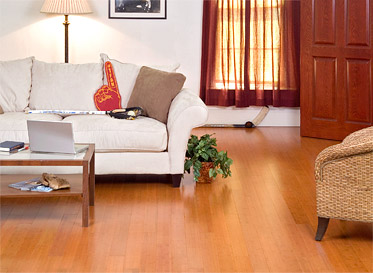
Figure 1 - A bamboo floor
Thin bamboo cane may seem almost flimsy when you picture it in your mind. The most commonly used flooring in North America is Red Oak, bamboo in comparison is 25% harder and just as strong.
When thinking about a hard
flooring material most people think of Rock Maple, yet bamboo is even harder, making bamboo an incredibly durable, impact resistant product for flooring.
Hardwood floors have a tendency to expand and contract, yet bamboo is much more stable as it contracts and expands 50% less than most hardwoods. This characteristic means that bamboo can be installed in homes and businesses located in geographic regions with high humidity and large temperature variations, that may make the installation of hardwoods impractical.
Available Options:
Bamboo is available as a high quality, tongue-and-groove, precision-milled board. Bamboo floorings are also available with vertical-grained and horizontal (face)-grained orientation.
When vertically milled, the individual nodes (the characteristic joint in the bamboo cane) are hard to discern, resulting in a consistent coloration and very even grain.
When milled in a horizontal-grain orientation, the individual nodes are visible with approximately four node strands apparent in each piece of flooring.
Though these two options are different in appearance they offer the home owner many more visual choices, yet they still offer the same strength characteristics.
Bamboo Colors:
There are two primary colors of bamboo flooring available in both horizontal and vertical milling. The first choice is its natural blonde hue, which reflects bamboo’s true color, along with its beautiful grain, growth patterns and joints. Using a smoking process, Bamboo is also available in a darker, amber tone. When bamboo is smoked, the carbonized grains take on a darker, richer, caramel or amber tone throughout the cane.
Selection Of Bamboo Flooring
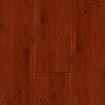
5/8″ X 3-3/4″ Arcadia Bamboo Flooring
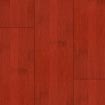
5/8″ X 3-3/4″ Bordeaux Bamboo Flooring
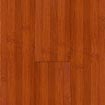
5/8″ X 3-3/4″ Dali Bamboo Flooring
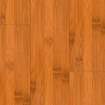
5/8″ X 3-3/4″ Miso Bamboo Flooring

9/16″ X 5″ Vertical Natural Bamboo
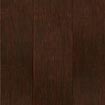
5/8″ X 3-3/4″ Sambuca Bamboo Flooring
Environmentally Speaking:
Bamboo is probably one of the most environmentally sensible flooring available to the home owner, offering a dependable, replenishable alternative to hardwood. Bamboo is technically a grass, not a tree, and it can be harvested in about five years.
Recognized as the fastest-growing plant on earth, bamboo offers 25 times the yield of hardwood, and is a much more sustainable and renewable resource.
Bamboo can be harvested and replenished with virtually no impact to the environment. Harvesting does not kill the plant, as does harvesting of all trees, because it constantly regenerates itself by sending out runners that result in new canes. Bamboo can be grown in soil damaged by overgrazing by domesticated livestock and poor agricultural techniques, and the topsoil is not damaged when the cane is harvested. Not only does the topsoil stay in place, the plant’s dense leaf cover actually improves the soil over time.
If protecting the environment and reducing the demand for over-harvested hardwoods is of importance to you then bamboo offers a strong, durable, beautiful floor that can accentuate any home or business.
Installation:
Bamboo flooring is installed in the same manner as any wood flooring material and can be installed by most DIY home handymen.
Additional information on the installation of bamboo and other wood floorings.
